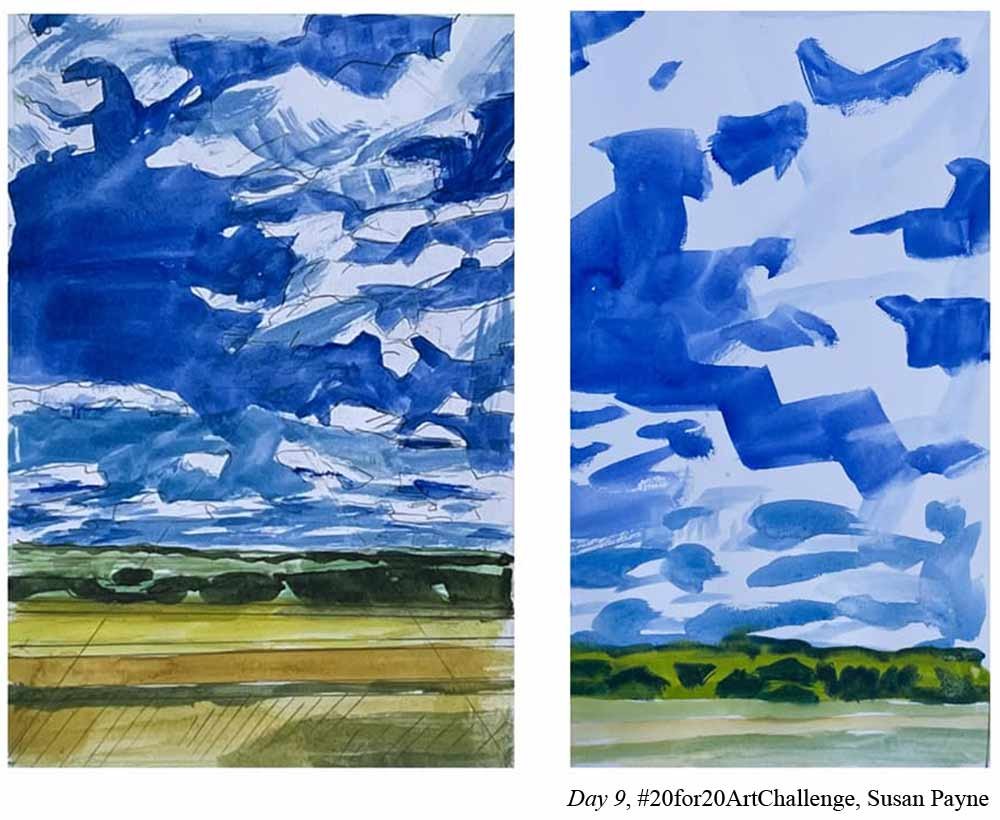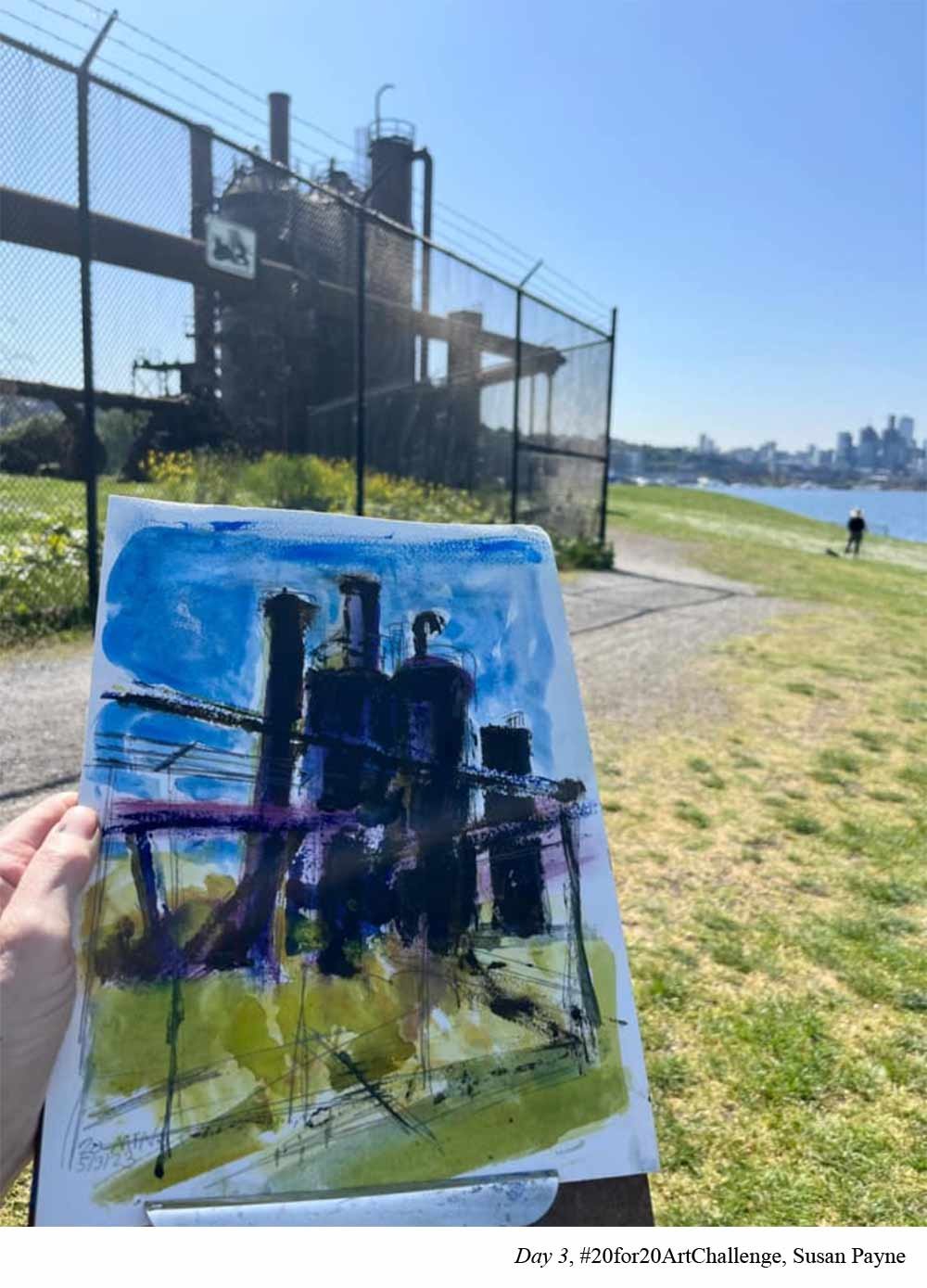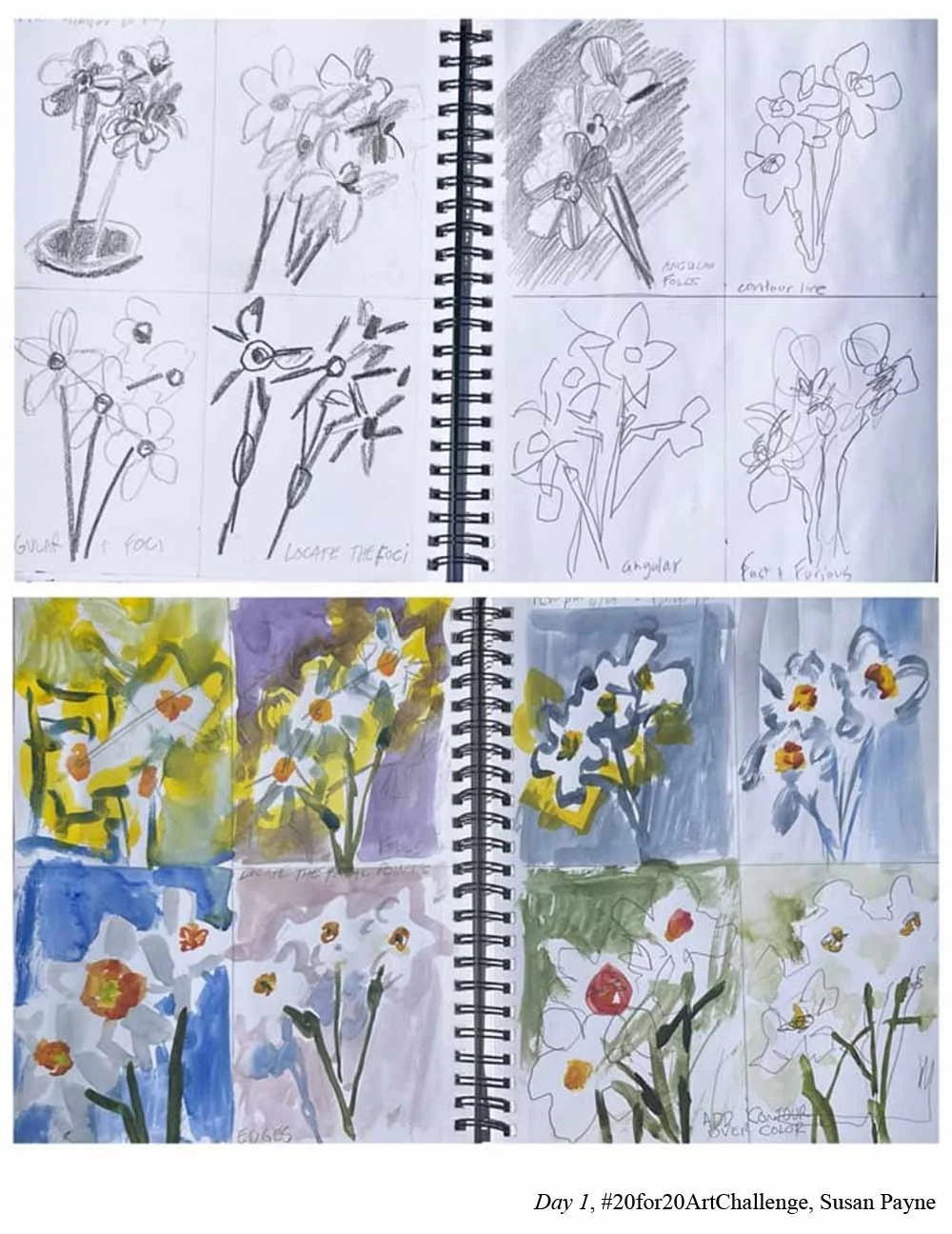Daily Practice - Artist Spotlight: Susan Payne
Whatever your art practice looks like, it has to work for you. That’s true when you have a ton of energy and focus. It’s even more especially true when life has given you very real health issues to manage.
Artist Susan Payne designed her #20for20 Challenge with health issues in mind. Because of this, she placed art time first thing in her day. She also knew that a varied schedule and subject matter would help keep her more interested.
Learn more about Susan Payne here.
How did you decide where in your day to put your 20? What kinds of things were you considering when planning that schedule (time, energy, other obligations?)
I usually try to do art work in the first part of the day because my energy level is generally better in the morning than in the afternoon and evenings.
Although I am basically retired, I do sometimes have a little bit of freelance work and I also fit in a daily walk outdoors.
I have an autoimmune disease that makes me extremely tired. I also had a stroke a few months ago and that’s added to that fatigue and attention problem.
Since becoming very ill in 2017, I’ve made painting and drawing somewhat of a priority. It helps my mood and mindfulness which are both important for my health.
So most days I do have time to fit in at least some artwork.
I do have a problem paying attention at home because I get distracted by household chores or because I tend to just want to fall asleep. So that’s one reason I plan some out of the house art sessions in parks and in the city.
Some days you kept the 20 and others you expanded beyond the 20. How did having it be “just 20 minutes” help you get into your space and start creating?
There were times I was going beyond the 20 in particular if I had a plein air or urban sketcher meetup. For those, I stayed involved typically 2 to 2.5 hours that day.
But if I had other work or appointments, I still tried to do 20 minutes of art somewhere, because it seems very helpful to my physical and mental health even in that short time.
When I chose to stay indoors and just use a 20for20 reference photo, I had a tendency to keep those sessions just 20 minutes. This minimal amount of time DID seem worthwhile to me to talk myself into doing some art even if I felt physically lousy that day, or felt too busy.
In fact, having to leave off somewhere when I just felt like I was getting started sometimes made me more interested in getting back to it the next day than if I had overworked myself the day before.
How did you decide which material to use each day? Did keeping those options open help you stay engaged in the challenge in a way that limiting may have not?
The materials I used depended on two things: what I was painting that day and the weather.
I do tend to do a lot of watercolors. Watercolor on paper works for me as long as it isn’t raining. That media also works well for me with my different groups; Urban Sketchers, my Watercolor Society Plein Air Group, and horse shows. Since these had such varied settings and subjects I wasn’t pursuing any consistent theme.
My space is limited but it isn’t a big problem for me to switch back and forth between indoor and outdoor painting or between sketching and watercolor. I keep almost all my plein air equipment in one backpack and bag so it’s easy to move from house to car.
I do use a larger palette indoors which sits next to my desk 24/7, always ready. My desk (table) is also my dinner and computer table but there’s enough room there to do art of less than 11x14 or so. Since I live alone I rarely need to move the art things out of the way.
My health has impacted the materials I use. When I do plein air, I’ve been using a lightweight chair rather than standing at an easel.
Memory problems due to my recent stroke also affected my choice of materials. One day I drove an hour to meet up with the Watercolor Society to paint in Seattle’s Gasworks Park. I realized I had totally forgotten to bring my roll of brushes, and I didn’t even have much in the way of other materials.
I ended up mostly painting watercolors with my fingertips and a stick (See image, Day 3, below). I was excited enough about the subject matter at that park, to experiment. Actually a couple other artists said they could lend me something but I kind of enjoyed the challenge of this limitation and some of the others really liked the energy that showed up in my work that day.
What were you hoping to explore? Why those goals? How is this different from how you'd worked previously? (schedule set up, materials, habit)
I do usually paint or draw several times a week, but this challenge got me to do it DAILY. I was hoping to explore the effects of a SHORT but daily session on my motivation.
I also haven’t taken any art classes in a few years. I found them very demanding but helpful in improving my work in the past. In a way I’ve been listening to Diane Shyne describe in the extended cut interview about working with a mentor and improving drawing skills and color theory. The Art Club Challenges seem to be a way I can get a little dose of skill building at less expense and time demand than a class.
Did the parameters you used help you explore more deeply? Why?
At first I didn’t feel attracted to the reference photos or other prompts of the Challenge. I was just interested in the challenge of posting daily short works.
But I got interested in the exercises shown by other participants and sometimes tried those out.
For example, there was a very simple landscape reference photo, and since I tend to do landscapes anyway it was interesting to see how other people treated ‘simplifying’ that composition and color exercise.
In terms of technical improvements I probably could have used a little more attention to a systematic approach like some participants were doing, but mixing it up at least kept me going and didn’t feel like School.
What benefits did you find working daily even if not for a long time? (learning benefits, anxiety benefits, just actually doing it benefits?)
It definitely reduced my anxiety about having to do a “real painting that I could enter in a competition or sell.” It was a lot easier to have the simple goal of ‘paint for 20 minutes and just leave enough energy to take a photo on my cell phone and post it.’
But not only that. It helped reduce my day to day challenges with mental health, especially morning anxiety. The Challenge helped me get myself involved in an activity that creates mindfulness and enjoyment rather than worrying about my personal problems and making to do lists.
With the florals I did during the challenge, I gravitated towards more abstract and energetic brush strokes because of the short time frame. Which I think was a great benefit.
I remember in particular a series of narcissus flowers (see below, Day 1) painted very fast but just studying different angles and colors to represent the same flowers quickly.
I think I did sometimes carry this “quick value and composition study” mentality into a longer painting on another day and it got me to paint bolder.
If someone wanted to follow your lead and do this specific Challenge (the way you set it up for yourself), any advice for them about what you’d change or what you’d make sure to not change? Why?
If I was more of a beginner artist or more of a ‘studio’ artist, I’d take the advice to try a more systematic approach or series of paintings.
As a plein air painter/ urban sketcher who has had previous classes in drawing and color theory but was struggling more with my time, energy and motivation, I feel like my approach worked okay for me.
What was the most helpful mindset for you to try and keep during the 20for20? Was there anything that was useful to remind yourself as you showed up each day? What was that and why?
That painting and drawing is about a process, mindfulness and meditation, not the final product. And that mental concentration can be achieved in a relatively short time.
So often the focus is on finished and beautiful work. Did you feel any difference in shifting the focus to the showing up? (The habit.) How did that change your relationship to your practice?
I think I already have a bit of a tendency towards ‘just enjoying the process” and could probably use a little more of the discipline to create finished products! But, I think I meet a lot of artists who worry quite a bit about the finished product, and sometimes it's not that fun for them.
I did have a life threatening health scare a few years ago and that did get me to focus more on ‘what do I want to do with my time in this precious life” and I also, before this challenge, had discovered the anxiety-reducing benefits of just doing art in small doses.
I was never an art major but studied and worked in the field of Architecture, including mostly computer drafting and administrative tasks. Art has always been my ‘release’ from that rather than a real discipline. It’s only fairly recently that I’ve been hoping for art to be a secondary source of income, since I can’t do architecture any more.
When I try for income production I tend to think that I need a little more discipline but don’t want to lose the FUN and exploration. And actually quite often the paintings people have wanted to buy were something I whipped out quickly - but probably the result of day after day of both practice AND play.
Learn more about Susan Payne here.
Learn more about the #20for20 here.








